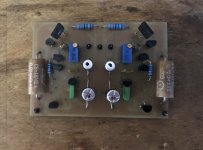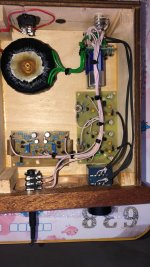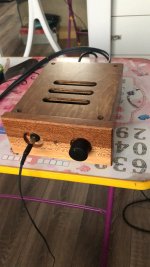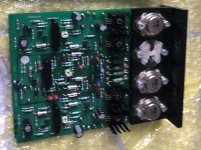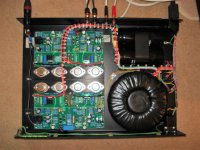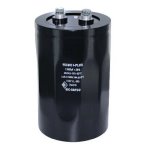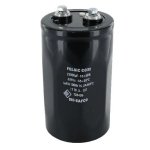Ignorance is sometimes a very useful tool. I should know. The challenge for the expert is to recognize that they need to think like an ignoramus when they are faced with an intractable riddle; somehow temporarily unlearn what they know. Only by re-learning from this humble position can the riddle be solved.
Personally, I tend to do my best at work when faced with a daunting task I've not done before. I think it's because it forces me to accept I have no clue. It's like humility makes me smarter...in the sense that it makes whatever smartness I have more effective.
Note to self: humility makes me smarter.
Personally, I tend to do my best at work when faced with a daunting task I've not done before. I think it's because it forces me to accept I have no clue. It's like humility makes me smarter...in the sense that it makes whatever smartness I have more effective.
Note to self: humility makes me smarter.
Good day
Dear gents
This experience is very interesting
I make the nap250 power reg without power transistors for headphone amp
And sound change 🙂
Also I trying connecting the lm317/337 to headphone amp but sound is not good.
Another side is nac preamp
Better sound with lm317 and not bad sound with nap250 power reg 🙂)
I think need try connecting the HI-CAP DR module for nac preamp..
In attachment 250 power reg in compact design for headphone amp
Dear gents
This experience is very interesting
I make the nap250 power reg without power transistors for headphone amp
And sound change 🙂
Also I trying connecting the lm317/337 to headphone amp but sound is not good.
Another side is nac preamp
Better sound with lm317 and not bad sound with nap250 power reg 🙂)
I think need try connecting the HI-CAP DR module for nac preamp..
In attachment 250 power reg in compact design for headphone amp
Attachments
Last edited:
As I understand, DR regulators are improved, discrete component replacements for the LM317 based regulator circuits that were formerly used to power Naim's outboard preamps, specifically those coupled to Naim's NAP250, 300 & 500 models. I'm not certain that they would also be suited to driving dynamic loads like headphones but your build of the DR module opens up opportunities for others to share here. Would you care to post some design details for us to try it out and also compare?
“DR“ it’s different design of discrete regulators in naim amps
This is not NAP250 reg schematic and not NAP250.2 reg
DR is absolutely new design and if you want try this for NAC preamp you need buy original HI-CAP DR
because some parts use in DR is not production (obsolete) in this time.
And you won’t buy the original parts for build DR
P.s. naim fabric storage have a big boxes with old parts for production and support to lifetime 🙂)
This is not NAP250 reg schematic and not NAP250.2 reg
DR is absolutely new design and if you want try this for NAC preamp you need buy original HI-CAP DR
because some parts use in DR is not production (obsolete) in this time.
And you won’t buy the original parts for build DR
P.s. naim fabric storage have a big boxes with old parts for production and support to lifetime 🙂)
Last edited:
My prototype of Headphone amp in wood case with small NAP250 power reg module
Attachments
Last edited:
How about sound
Sound is same effect with NAP140 amp with NAP250 power regs boards
More bass strong effect and more power
But need more time for warm if turn on power
Sound is same effect with NAP140 amp with NAP250 power regs boards
More bass strong effect and more power
But need more time for warm if turn on power
The NAP250.2 original board
I not turn on this because the board not have one transistor NA00
This new naim design is not have a protection circuit some like old NAP250
Also I check another NAP300 and NAPDR his not have protection circuit too
I think new engineers have very scary watching to old naim technologies
I not turn on this because the board not have one transistor NA00
This new naim design is not have a protection circuit some like old NAP250
Also I check another NAP300 and NAPDR his not have protection circuit too
I think new engineers have very scary watching to old naim technologies
Attachments
Answering the original question of this thread: yes I compared with and without regulation, see my postings in various NAP clone threads on this, and I also commented on Mundorf vs. Kemet smoothers in the PSU. I made new regulator boards recently and will post about them as soon as I completed some more tests...
.........not only independent of the frequency (datasheet unfortunately mentioned the values mostly for two frequencies - 100Hz and 10KHz) but also independent of the peak currents (surge currents) that occur.Although capacitance is essence of what capacitor is, single most important property of any PS capacitor is impedance across the whole audio band. It should be very low......
Though, one property is not enough to determine if capacitor is best fit for an intended duty.
Most mid-range electrolytic capacitors are probably already superior to a voltage series regulator especially high-quality versions with screw terminals like those from SicSafco.
I can still remember a listening test, where the same types of capacitors with the same values were connected externally in parallel mode to the present small caps to the output of the voltage regulator on the NAP250 as already present at the input of the voltage regulator (interesting experiment - unfortunately not without risk of damage).
The inherent sound of the voltage regulator disappeared completely and the sound character changed in such a way that both the resolution and the holographic representation were significantly improved (same observations I had make on Linn's LK280 and Klout - both power amp devices operates with serial voltage regulators with small caps on the outputs).
Unfortunately this is very very laborious, because there are some additional steps necessary to avoid the destroy of the voltage regulator parts.
In series to the additional big caps in the voltage rails I introduce 1K resistors. After switch-on and waiting until charge of this caps was done, first listening test was carried out.
Second step before start second listening test was disconnect the speaker cables and shorting the 1K resistors in serial to the added caps and connect speakers again after several seconds (without switch-off and switch-on again !!!).
Before switch-off the power amp after this second listening test speaker cables must disconnect additional the additional capacitors (important, because otherwise the discharge of the additional big capacitors destroy the voltage regulator.
Now the question: what additional steps are necessary around the serial voltage regulator, so that capacitors with high capacity can be connected behind it without getting transients due charging current peaks and unwanted discharge currents during switching on and switching off ???
P.S.: the showed caps in the images are one of the best sounded I know (together with those from Mundorf's Mlytic HC and FTcap).
Attachments
Last edited:
Good day
Dear tiefbassuebertr
On yours photos is not Naim boards
And sound different with compare original boards
And power regs needed for original Naim nap250 boards his added strong bass and more detailed sound
I don’t known how sound on yours green boards on photo
Dear tiefbassuebertr
On yours photos is not Naim boards
And sound different with compare original boards
And power regs needed for original Naim nap250 boards his added strong bass and more detailed sound
I don’t known how sound on yours green boards on photo
I agree on that because most voltage regulator designs took care only of ripple and were very lacking in transient response. Bad transient response is the source of specific “sound of voltage regulator”, while voltage regulator should be absolutely neutral. Large output capacitors can help there, but they can burn main regulating semiconductor with large initial charging current, if regulator was not designed to tolerate that.I can still remember a listening test, where the same types of capacitors with the same values were connected externally in parallel mode to the present small caps to the output of the voltage regulator on the NAP250 as already present at the input of the voltage regulator (interesting experiment - unfortunately not without risk of damage).
Good voltage regulator should keep output changes in the sub single mV level during most extreme fast load demands from the amplifier. Such design would allow amplifier to present its maximum in reproduction details and soundstage. Results can be simply unbelievable.
It would be a very simple circuit with one power resistor connecting additional capacitor, bypassed by relay with desired RC time constant to bypass resistors after several seconds, or even by simple manual switch for quick testing.Now the question: what additional steps are necessary around the serial voltage regulator, so that capacitors with high capacity can be connected behind it without getting transients due charging current peaks and unwanted discharge currents during switching on and switching off ???
- Home
- Amplifiers
- Solid State
- Really better Sound through use of additional Voltage Regulator in NAIM Audio's Chrome Bumper Power Amp NAP250 (compared with NAP160/NAP110)?
